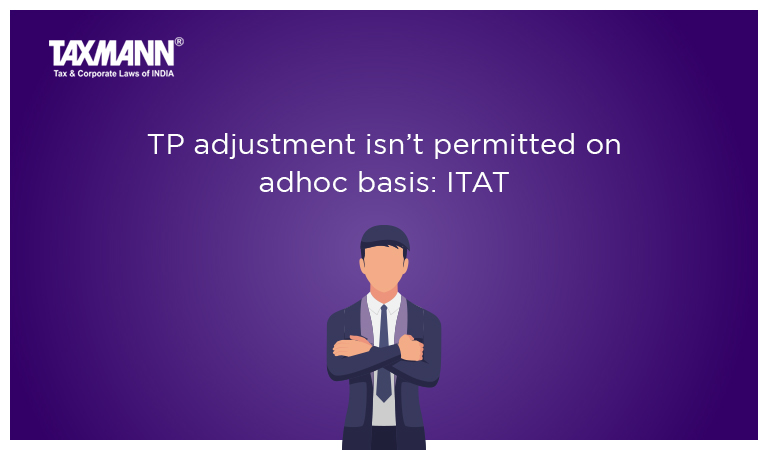TP adjustment isn’t permitted on adhoc basis: ITAT
- Blog|News|Transfer Pricing|
- 2 Min Read
- By Taxmann
- |
- Last Updated on 26 September, 2022

Case Details: HSBC Asset Management (India) (P.) Ltd. v. DCIT - [2022] 140 taxmann.com 476 (Mumbai-Trib.)
Judiciary and Counsel Details
-
- Vikas Awasthy, Judicial Member & M. Balaganesh, Accountant Member
- Porus Kaka, Divesh Chawla & Tejas Mhatre for the Appellant.
- Satya Pinisetty for the Respondent.
Facts of the Case
The assessee had received services from AEs towards software development and other IT services & support services. For providing these services, AEs had charged certain costs to the assessee based on the appropriate allocation key.
The details of cost allocation keys used for the purpose of allocation of cost to the assessee were duly documented in the TP study report and were submitted before the TPO. However, the TPO held that the transactions of cost allocation were not at arm’s length and proceeded to make an ad hoc disallowance of 50 percent. The matter reached before the Mumbai Tribunal.
ITAT Held
The Mumbai Tribunal has held that the entire transfer pricing adjustment in respect of cost allocation had been made by the TPO completely on an ad hoc basis without carrying out the benchmarking analysis by following any of the prescribed methods provided in the statute.
It was specifically submitted that with respect to the services, the cost allocation that has been made to the assessee was purely based on a cost-to-cost basis based on actual usage. Further, the assessee had submitted evidence to the TPO to demonstrate the fact that services had indeed been obtained from the AE.
Hence, it could be safely concluded that the assessee had indeed availed the services and derived benefits thereon by incurring the cost paid to AE based on cost allocation depending on actual usage without any markup thereon.
Hence, the assessee duly discharged its onus of justifying the claim of expenses paid to its AE towards cost allocation of software development and other IT services. In any case, the TPO ought not to have disallowed 50 percent of the said expenditure on an ad hoc basis. The TPO is duty bound to determine the ALP of an international transaction only by following any of the five prescribed methods provided in rule 10B of the Income-tax Rules and not otherwise.
List of Cases Reviewed
-
- Carlyle India Advisors (P.) Ltd. v. Asstt. CIT [2012] 24 taxmann.com 176/53 SOT 267 (Mum.) (URO)
- Pr. CIT v. Blackstone Advisors India (P.) Ltd. [2020] 114 taxmann.com 220 (Bom.) (para 3.8)
- CIT v. Johnson & Johnson Ltd. [2017] 80 taxmann.com 337 (Bom.) (para 5.4) followed.
List of Cases Referred to
-
- Carlyle India Advisors (P.) Ltd. v. Asstt. CIT [2012] 24 taxmann.com 176/53 SOT 267 (Mum.) (URO) (para 3.8)
- CIT v. Carlyle India Advisors (P.) Ltd. [2013] 32 taxmann.com 23/214 Taxman 492/357 ITR 584 (Bom.) (para 3.8)
- Pr. CIT v. Blackstone Advisors India (P.) Ltd. [2020] 114 taxmann.com 220 (Bom.) (para 3.8)
- CIT v. Johnson & Johnson Ltd. [2017] 80 taxmann.com 337 (Bom.) (para 5.4).
Disclaimer: The content/information published on the website is only for general information of the user and shall not be construed as legal advice. While the Taxmann has exercised reasonable efforts to ensure the veracity of information/content published, Taxmann shall be under no liability in any manner whatsoever for incorrect information, if any.

Taxmann Publications has a dedicated in-house Research & Editorial Team. This team consists of a team of Chartered Accountants, Company Secretaries, and Lawyers. This team works under the guidance and supervision of editor-in-chief Mr Rakesh Bhargava.
The Research and Editorial Team is responsible for developing reliable and accurate content for the readers. The team follows the six-sigma approach to achieve the benchmark of zero error in its publications and research platforms. The team ensures that the following publication guidelines are thoroughly followed while developing the content:
- The statutory material is obtained only from the authorized and reliable sources
- All the latest developments in the judicial and legislative fields are covered
- Prepare the analytical write-ups on current, controversial, and important issues to help the readers to understand the concept and its implications
- Every content published by Taxmann is complete, accurate and lucid
- All evidence-based statements are supported with proper reference to Section, Circular No., Notification No. or citations
- The golden rules of grammar, style and consistency are thoroughly followed
- Font and size that’s easy to read and remain consistent across all imprint and digital publications are applied





